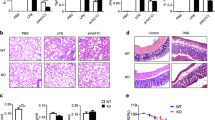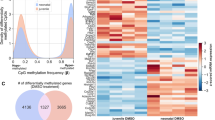Abstract
The unmethylated CpG motifs within E. coli DNA (EC) cause immune stimulation. In contrast, mammalian DNA such as calf thymus (CT) DNA had been thought to be immunologically inert. In this article, we demonstrate that CT DNA unexpectedly specifically inhibits the immune activation by EC but not that by endotoxin. This inhibitory effect was mediated in the signaling pathway activated by EC since CT DNA markedly inhibited the CpG-induced nuclear translocation of the transcription factors, NF-κB and AP-1. In addition, CT DNA significantly inhibited the synergistic immune activation by EC and endotoxin. The mechanism of the inhibition by CT DNA probably did not involve the inhibition of the cellular uptake of EC. Using a CpG-depleted plasmid, we demonstrated that CpG methylation played an important role in the inhibition by CT DNA. Compared with unmethylated plasmid DNA, CpG-methylated DNA inhibited the immune activation by EC to the same extent as did CT DNA. Importantly, the inhibitory effect of CT DNA was also observed in vivo. Our results suggest that methylated DNA may be applied to alleviate the unwanted immune stimulation and inflammation in systemic inflammatory response syndrome and in gene therapy with plasmid DNA.
This is a preview of subscription content, access via your institution
Access options
Subscribe to this journal
Receive 12 print issues and online access
$259.00 per year
only $21.58 per issue
Buy this article
- Purchase on Springer Link
- Instant access to full article PDF
Prices may be subject to local taxes which are calculated during checkout









Similar content being viewed by others

References
Messina JP, Gilkeson GS, Pisetsky DS . Stimulation of in vitro murine lymphocyte proliferation by bacterial DNA J Immunol 1991 147: 1759–1764
Tokunaga T et al. Antitumor activity of deoxyribonucleic acid fraction from Mycobacterium bovis BCG. I. Isolation, physicochemical characterization, and antitumor activity J Natl Cancer Inst 1984 72: 955–962
Shimada S et al. Antitumor activity of the DNA fraction from Mycobacterium bovis BCG. II. Effects on various syngeneic mouse tumors J Natl Cancer Inst 1985 74: 681–688
Krieg AM et al. Sequence motifs in adenoviral DNA block immune activation by stimulatory CpG motifs Proc Natl Acad Sci USA 1998 95: 12631–12636
Krieg AM et al. CpG motifs in bacterial DNA trigger direct B-cell activation Nature 1995 374: 546–549
Sato Y et al. Immunostimulatory DNA sequences necessary for effective intradermal gene immunization Science 1996 273: 352–354
Klinman DM, Yamshchikov G, Ishigatsubo Y . Contribution of CpG motifs to the immunogenicity of DNA vaccines J Immunol 1997 158: 3635–3639
Zabner J et al. Comparison of DNA–lipid complexes and DNA alone for gene transfer to cystic fibrosis airway epithelia in vivo J Clin Invest 1997 100: 1529–1537
Freimark BD et al. Cationic lipids enhance cytokine and cell influx levels in the lung following administration of plasmid: cationic lipid complexes J Immunol 1998 160: 4580–4586
Yew NS et al. Contribution of plasmid DNA to inflammation in the lung after administration of cationic lipid:pDNA complexes Hum Gene Ther 1999 10: 223–234
Schwartz DA et al. CpG motifs in bacterial DNA cause inflammation in the lower respiratory tract J Clin Invest 1997 100: 68–73
Deng GM et al. Intra-articularly localized bacterial DNA containing CpG motifs induces arthritis Nat Med 1999 5: 702–705
Cowdery JS, Chace JH, Yi AK, Krieg AM . Bacterial DNA induces NK cells to produce IFN-gamma in vivo and increases the toxicity of lipopolysaccharides J Immunol 1996 156: 4570–4575
Sparwasser T et al. Bacterial DNA causes septic shock Nature 1997 386: 336–337
Gao JJ et al. Cutting edge: bacterial DNA and LPS act in synergy in inducing nitric oxide production in RAW 264.7 macrophages J Immunol 1999 163: 4095–4099
Li S et al. Effect of immune response on gene transfer to the lung via systemic administration of cationic lipidic vectors Am J Physiol 1999 276: L796–L804
Tan Y, Li S, Pitt BR, Huang L . The inhibitory role of CpG immunostimulatory motifs in cationic lipid vector-mediated transgene expression in vivo (see comments) Hum Gene Ther 1999 10: 2153–2161
Yew NS et al. Reduced inflammatory response to plasmid DNA vectors by elimination and inhibition of immunostimulatory CpG motifs Mol Ther 2000 1: 255–262
Wloch MK, Pasquini S, Ertl HC, Pisetsky DS . The influence of DNA sequence on the immunostimulatory properties of plasmid DNA vectors Hum Gene Ther 1998 9: 1439–1447
Pisetsky DS, Reich CF . Inhibition of murine macrophage IL-12 production by natural and synthetic DNA Clin Immunol 2000 96: 198–204
Kimura Y et al. Binding of oligoguanylate to scavenger receptors is required for oligonucleotides to augment NK cell activity and induce IFN J Biochem (Tokyo) 1994 116: 991–994
Yi AK et al. CpG motifs in bacterial DNA activate leukocytes through the pH-dependent generation of reactive oxygen species J Immunol 1998 160: 4755–4761
Yi AK, Krieg AM . Rapid induction of mitogen-activated protein kinases by immune stimulatory CpG DNA J Immunol 1998 161: 4493–4497
Sparwasser T et al. Macrophages sense pathogens via DNA motifs: induction of tumor necrosis factor-alpha-mediated shock Eur J Immunol 1997 27: 1671–1679
Stacey KJ, Sweet MJ, Hume DA . Macrophages ingest and are activated by bacterial DNA J Immunol 1996 157: 2116–2122
Raz E et al. Preferential induction of a Th1 immune response and inhibition of specific IgE antibody formation by plasmid DNA immunization Proc Natl Acad Sci USA 1996 93: 5141–5145
Gribaudo G et al. Interferons inhibit onset of murine cytomegalovirus immediate–early gene transcription Virology 1993 197: 303–311
Ritter T et al. Stimulatory and inhibitory action of cytokines on the regulation of hCMV-IE promoter activity in human endothelial cells Cytokine 2000 12: 1163–1170
Qin L et al. Promoter attenuation in gene therapy: interferon-gamma and tumor necrosis factor-alpha inhibit transgene expression Hum Gene Ther 1997 8: 2019–2029
Harms JS, Splitter GA . Interferon-gamma inhibits transgene expression driven by SV40 or CMV promoters but augments expression driven by the mammalian MHC I promoter Hum Gene Ther 1995 6: 1291–1297
Hug M et al. Transcriptional repression by methylation: cooperativity between a CpG cluster in the promoter and remote CpG-rich regions FEBS Lett 1996 379: 251–254
Parker SE et al. Cancer gene therapy using plasmid DNA: safety evaluation in rodents and non-human primates (see comments) Hum Gene Ther 1995 6: 575–590
Zhao H, Cheng SH, Yew NS . Requirements for effective inhibition of immunostimulatory CpG motifs by neutralizing motifs Antisense Nucleic Acid Drug Dev 2000 10: 381–389
Davis HL, Millan CL, Watkins SC . Immune-mediated destruction of transfected muscle fibers after direct gene transfer with antigen-expressing plasmid DNA Gene Therapy 1997 4: 181–188
Vieira J, Messing J . New pUC-derived cloning vectors with different selectable markers and DNA replication origins Gene 1991 100: 189–194
Ge L, Rudolph P . Simultaneous introduction of multiple mutations using overlap extension PCR Biotechniques 1997 22: 28–30
Acknowledgements
We thank Martin Schleef (Qiagen, Hilden Germany) for providing the pUK21 vector. AM Krieg is supported by a Career Development Award from the Department of Veterans Affairs and the National Institutes of Health (DK25295, DK54759, and CA66570), DARPA, and the Cystic Fibrosis Foundation. Additional support was provided by the Coley Pharmaceutical Group, Wellesley, MA.
Author information
Authors and Affiliations
Rights and permissions
About this article
Cite this article
Chen, Y., Lenert, P., Weeratna, R. et al. Identification of methylated CpG motifs as inhibitors of the immune stimulatory CpG motifs. Gene Ther 8, 1024–1032 (2001). https://doi.org/10.1038/sj.gt.3301482
Received:
Accepted:
Published:
Issue Date:
DOI: https://doi.org/10.1038/sj.gt.3301482
Keywords
This article is cited by
-
Plasmid CpG Depletion Improves Degree and Duration of Tumor Gene Expression After Intravenous Administration of Polyplexes
Pharmaceutical Research (2008)
-
TLR-9 Activation of Marginal Zone B Cells in Lupus Mice Regulates Immunity Through Increased IL-10 Production
Journal of Clinical Immunology (2005)
-
IL-18 gene therapy develops Th1-type immune responses in Leishmania major-infected BALB/c mice: is the effect mediated by the CpG signaling TLR9?
Gene Therapy (2004)
-
Immune responses to gene therapy vectors: influence on vector function and effector mechanisms
Gene Therapy (2004)
-
A role for Toll in autoimmunity
Nature Immunology (2002)


